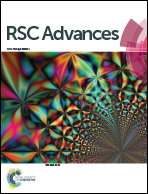A visualized method for Cu2+ ion detection by self-assembling azide functionalized free graphene oxide using click chemistry†
Abstract
We report a visualized method for the detection of Cu2+ ions, which relies on the Cu(I)-catalyzed 1,3-dipolar cycloaddition of alkynes on the surface of functionalized QDs and azides on the surface of functionalized graphene oxide (GO). This click chemistry process results in self-assembly of GO-N3 sheets into aggregates that can be observed by the naked eye. The catalyst, Cu(I), was conveniently derived from the reduction of Cu(II) in the presence of sodium ascorbate, thereby allowing the reaction to serve as a naked eye method to assay for the presence of Cu2+ ions.


 Please wait while we load your content...
Please wait while we load your content...